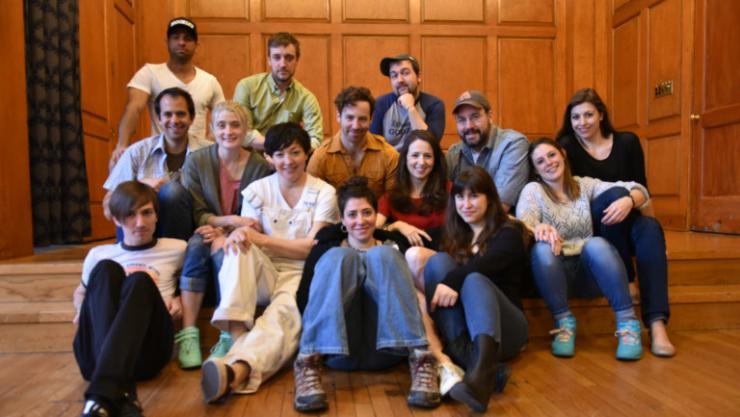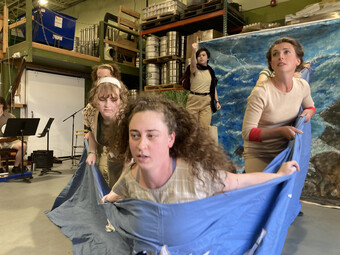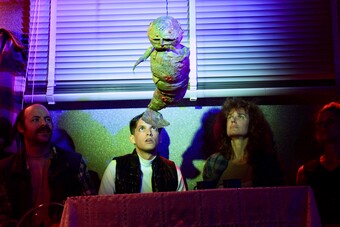Ensembles
How To Model One?
Creating ensemble-based theatre is one thing. Paying for it is another. Jeffrey Mosser does three case studies of established ensemble theatres exploring the creating and paying for the art.
Well-known for its multi-faceted productions of narrated and physical theatre, The TEAM, based in New York, devises with an ensemble—a core. Their dedication to process and devising reinforces a part of their artistic-based decision making model. Over the past ten years they have received a lot of attention for their aesthetic and their work at the Under the Radar Festival, National Theatre of Scotland, and the Edinburgh Fringe Festival. Especially interesting is their ability and interest in touring, which requires, and may reap, quite a bit of funding. With grant-writing and producing at the forefront they have brought on a producing director, Manda Martin who manages day to day as well as long term planning. She joined Rachel Chavkin and I for this interview.
“We were a Cinderella story of the Edinburgh Fringe that year,” says Rachel Chavkin, The TEAM’s director. In 2004 she got a group of friends together and decided to do a show. “None of us identified as administrators or writers” and nobody had the intention of creating a company. After three years things were changing… quickly. After that moment at the Fringe, the National Theatre of Scotland asked them point blank, “What are you coming back with next year?” They were a group of NYU alumni who realized there was more to what they were doing.
The Who and the What
The TEAM’s full process from concept to completion is very flexible as evidenced by their show Mission Drift which took five years to develop. Though it may seem to be a long time, The TEAM is dedicated to working with their core and will frequently postpone rehearsal in order to work with the ensemble. Also, each person is paid for their rehearsal time, so finding payment is part of the process. Their ideas tend to grow out of previous projects, and ideas that aren’t quite ready politely get passed on. “It tends to be you get a lot of ‘good job’ instead of ‘we should build on that!’ then it slowly dies…” states Chavkin. “But artistically, it is almost entirely horizontal with me as the final decider on topics where the group does not reach consensus. That has always been important for creation because [the ensemble members] know at the end of the day that there is one set of tastes that the piece is going through, but creation wise it would be hard to say that one person is the lead writer.”
Their ensemble has two strata of membership: Core Members and Artistic Associates. Core Members are asked to contribute to the longevity of the company (board meetings, administration, etcetera). The rehearsal process is open to all and a sound designer is always present. Additional designers are brought in as they reach a more substantial work-in-progress showing. Conscientious of their artists, The TEAM will postpone rehearsals or development in favor of working around their ensemble’s schedules. They also understand to strike when the iron is hot and assemble quickly for a tour, workshop, or other opportunity at a moment’s notice.
As they begin to shift out of development mode and into rehearsal mode Chavkin cites that there is an artistic shift that takes place. “We actually tend to shift into a hierarchical set up... we have to stop solving problems as writers.” They begin to use their tools as actors and director to address problems. If they kept writing to problem solve their own show they’d “risk flattening out the script in order to make it accessible.” Which is not to say they ever fully stop making edits to the text.
“We got our first real co-production support from the National Theatre of Scotland and our organizational budget… moved from $50,000 to $120-180,000.” From there they hired someone to work administratively: payroll, accounting, budgeting. By 2008 they were a group of thirteen including core members, artistic associates, and their first staff person.
They were friends who gave incredible guidance, but eventually the board transitioned into something that supports fiscally as well as passionately.

At that point they established as a nonprofit and had developed a board, which included founding members and friends who had arts administration backgrounds. They were friends who gave incredible guidance, but eventually the board transitioned into something that supports fiscally as well as passionately. “Now we’re in a place where we’re trying to build on those relationships to sustain the company as it continues to evolve,” mentions producing director, Manda Martin.
Producing Something You’ve Never Heard Of
So how does an ensemble that devises something from nothing put into writing why they should be funded? “I think that’s something that we’re inventing every time we write a grant,” Martin explains, “and it’s part of the reason we have partners [like the National Theatre of Scotland and PS122] who have vested interest in The TEAM.” These partners provide a certain amount of onus and endorsement to the group while their production’s details are still in development. Grant funding for theatre is still learning how to deal with devised/ensemble pieces. There isn’t a strong vocabulary for the process. “You have to talk about the strengths of the project, often before you know fully where the process will take you.”
Their flexible artistic process, which could be considered jarring to any other board or funder, is transparently communicated. “We tend to work in stages,” Chavkin adds, “grants and producing partners tend to sign on for a part of the development: this two-week workshop, that month-long residency.” Grants and contributed revenue are a major part of The TEAM’s funding. Even rehearsals are based on funding—“Perhaps two to three months of a year? For Architecting, which was a three year process, we rehearsed about seven months. Rehearsal for us is really about generating. And still we rewrite and rewrite.”
“As far as earned versus contributed revenue goes,” Chavkin adds, “it radically changes. Some years we’re just in development. Our main income is co-producing/presenting the work and touring.” Recently they’ve been able to draw a portion of the box office funds because of royalties to the show, as well as earn some co-production support. When the group is in development however, these numbers radically change as they need to support a growing administrative infrastructure. With grants for general operating support being few and far between those tours are necessary to fill the coffers.
***
So what is the model? Where is the Venn Diagram? Which flowchart should I follow to start my ensemble theatre? From the similarities of these three case studies I’ve attempted to generate some stepping-stones.
Follow what resonates loudest within the group, and don’t worry if you hit a dead-end—you’ve always got other ideas to come back to.
Find your tribe. These are people who share your same ideals, but more importantly that you like and trust. Maybe you do a project together and think, “Yea, we could do more of this together.” That’s your first clue to saying maybe we have a company/ensemble here. Can you agree on your purpose? Methodology? How are you going to continue working together? Can you agree on a vision and mission together?
Play your strengths. Each person in your group has a different outlook, set of experiences, and interests. Feed those interests, share ideas. If this is a group you can truly trust, you won’t be afraid to share your best ideas.
Make. Come to a consensus about what intrigues you. This can come from an open training process, a list of ideas you’ve always wanted to explore, or a list of titles and roles you’ve never gotten to play. Follow what resonates loudest within the group, and don’t worry if you hit a dead-end—you’ve always got other ideas to come back to. Ask yourselves, “How do we want to make this?” and remember to play your strengths here too.
Develop a timeline. Once you’ve got a kernel of the idea, try to chase down the stages of development. Do you want a reading? A workshop? Can you even imagine a performance date yet? Maybe you have a three-show season. Most importantly: don’t force a timeline, rather keep the pressure of deadlines (financial, creative, personal). Ask yourself what does the show needs in order to grow?
Showing up is half the battle. As my mom says, “Decisions are made by those who show up.” In each ensemble I interviewed they have a process of contributing ideas, solutions, and connections to the piece. Each group may have different strata for their membership in terms of who decides the trajectory of the theatre, but with artist-based decision-making they all discuss the creative process together with equal footing.
Aesthetics. You started making this piece with a kernel of an idea—perhaps a question you wanted to answer. Remember that you need to provide the shape for that aesthetic. Perhaps that means within the process adopting more traditional roles to shape the play. Each group had a variation on their mostly egalitarian process, which eventually transitioned to a more hierarchical structure. It depends on the style of your own ensemble, but know who should and when to take the reins.
Produce it. Fundraise, chip in, find (cheap) space, tell people, do it. Make a plan. Do it again.
Grow as you need to grow. There’s no sense in setting up all kinds of overhead without the content for it. As an ensemble, when you need an artistic director, a producer, a writer, or administrator you will know. Think of your theatre company as a small boat—you have to like and need everyone in it, or else you’re going to sink.
Fundraising … is not a dirty word. Funding can determine speed and rate of growth. It is a necessary word and can boost morale to know what freedoms and possibilities are available. Talk in your group about expectations, needs, and










Comments
The article is just the start of the conversation—we want to know what you think about this subject, too! HowlRound is a space for knowledge-sharing, and we welcome spirited, thoughtful, and on-topic dialogue. Find our full comments policy here
Just seeing this now. Thanks, Edward!
Also -- for a peek into the emotion surrounding this process check out the TEAM's video below.
http://vimeo.com/67351750#at=0
Thanks, Edward! Just seeing this now for the first time!
Also -- for a peek into the emotion surrounding this process check out the TEAM's video below.
http://vimeo.com/67351750#at=0
It seems to me a successful ensemble organization mirrors any successful organization of the 21st century. You need to find the right people, know them, and know what methods can work best for them. It just happens to be in our case that our output is live stories... but all the fundamental organizational rules still apply.
When we get caught up in trying to emulate the form, timelines, and philosophies of other companies, productions, and ensembles we get tripped up ( this is something I think we all are guilty of) because we are not responding to our present reality. It seems like your advice boils down to know thyself and I think that is really on point and worth discussing what that means.
p.s. And I would say you are doubly right about this applying to not just ensemble based theatres but the traditional company model as well.